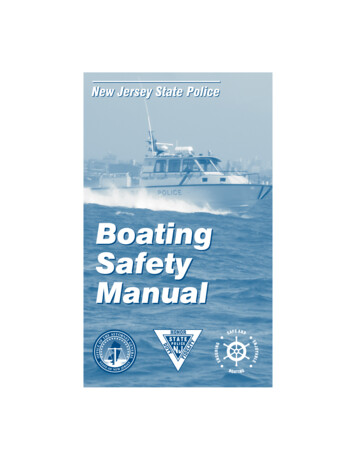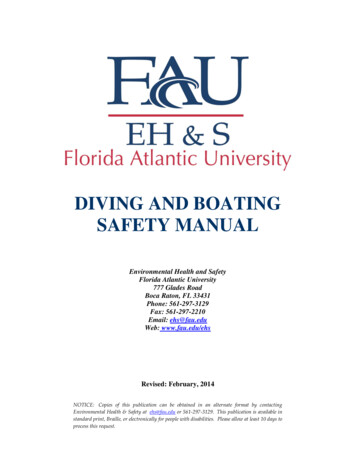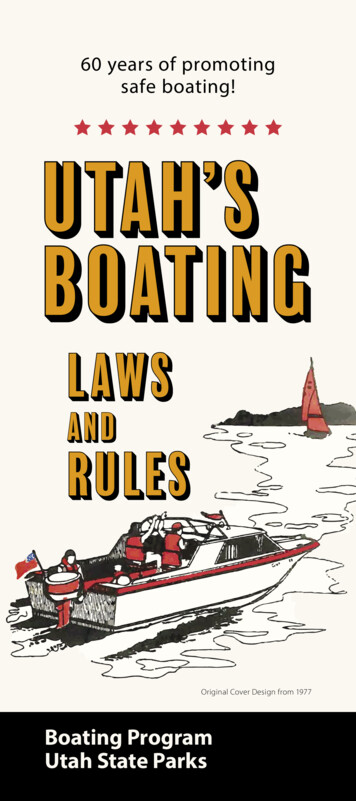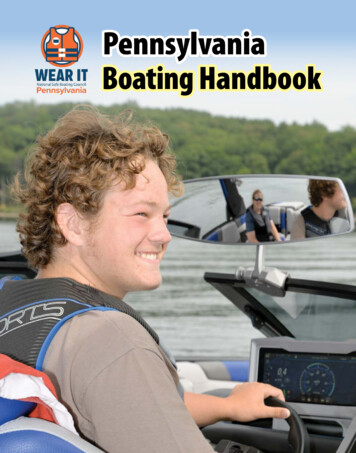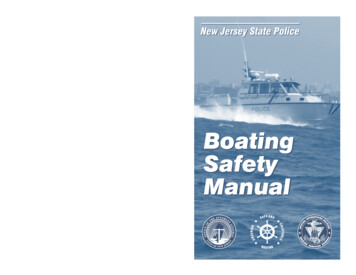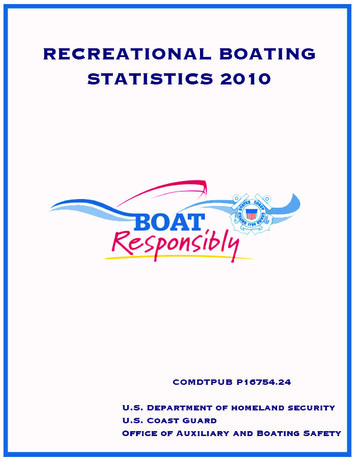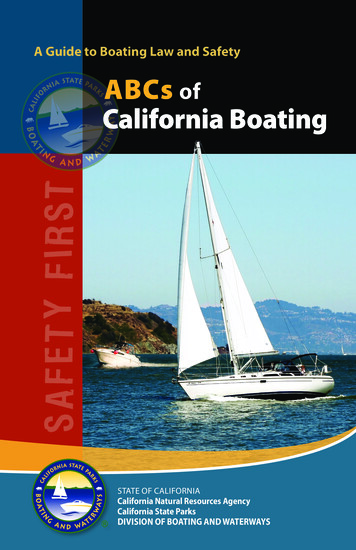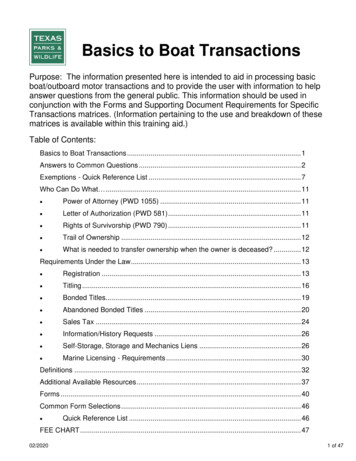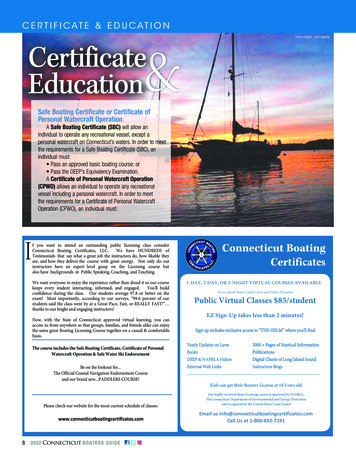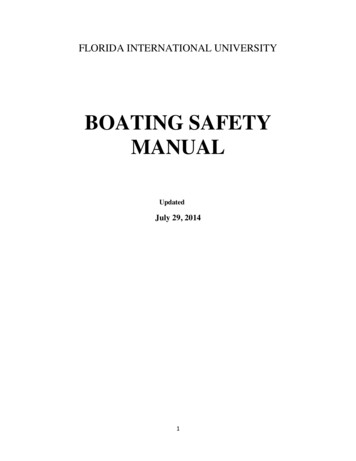
Transcription
FLORIDA INTERNATIONAL UNIVERSITYBOATING SAFETYMANUALUpdatedJuly 29, 20141
Table of Contents1.0 INTRODUCTION21.1 PURPOSE1.2 SCOPE1.3 REFERENCES1.4 DEFINITIONS1.5 PROGRAM ADMINISTRATION, RESPONSIBILITY, AND ACCOUNTABILITY2.0 BOATING SAFETY PROGRAM REQUIREMENTS2.1 BOAT OPERATIONS2.2 MOTOR BOAT SAFETY REQUIREMENTS2.2.1 MOTOR BOAT OPERATOR AND CREW TRAINING2.2.2 PERSONAL PROTECTIVE EQUIPMENT (PPE)2.2.3 BOAT SAFETY EQUIPMENT2.2.4 OPERATIONAL SAFETY PROCEDURES2.3 MINIMIZING IMPACT ON THE ENVIRONMENT2.4 COMMUNICATIONS2.5.0 EQUIPMENT INSPECTIONS63.0 ACCIDENT REPORTING4.0 Motor boating Personal Qualification Standards (PQS )Motorized boats up to 20’ in confined water bodiesBoats 21’ to 26’ in fresh or marine watersResearch Vessel Captain (Crew Chief) For Boats Over 26 feet (Unrestricted)5.0 AIRBOAT SAFETY REQUIREMENTS5.1 AIRBOAT OPERATOR AND BOAT CREW TRAINING5.2 AIRBOATING PERSONAL PROTECTIVE EQUIPMENT5.3 AIRBOATING SAFETY EQUIPMENT5.4 AIRBOAT OPERATIONAL SAFETY PROCEDURES5.5 ACCIDENT REPORTING5.6 Airboat Personal Qualification Standard (PQS)2
1.0 INTRODUCTIONVessel operation is critical to realization of Florida International University’s research andteaching goals in environmental science. FIU researchers and teachers use boats routinely inSouth Florida’s inland and offshore waters, as well as in locations distant from campus. Thisdocument provides policies and procedures for safe boating by FIU faculty, staff, and students,as well as mechanisms for enforcement of these policies.FIU policies establish roles for faculty, staff and students that are linked to minimum trainingstandards. Boaters are classified as a crew chief, boat crew, science crew, student or observerbased on their role in a boat trip. Safe boating requires that all members of the crew demonstratewater skills and local knowledge regarding the research area and boat operations. The crewchief and crew must be able to recognize limitations of their equipment and personnel and makesafety decisions using that information to insure the welfare of everyone on board.1.1 PURPOSEThe Florida International University Boating Safety Manual provides safety guidelinesapplicable to research operations involving the use of watercraft. The policy statements,recommendations, and guidelines provided here are meant to be minimum standards and are notintended to replace common sense; universally applicable guidelines for the diversity of marineresearch and teaching activities and conditions are not possible.The goals of this manual are: establish safe practices as the primary concern for all boating activities by FIU students,employees and visitors;facilitate the effectiveness and efficiency of research operations through use of safepractices;promote environmentally sensitive practices by FIU boating research programs;control financial costs while maintaining safe boating practice.1.2 SCOPEThe FIU Boating Safety Manual applies to all FIU sanctioned research and teaching activitiesinvolving the use of any type of watercraft.1.3 REFERENCES 46 CFR, U.S. Coast Guard, Department of Transportation, Requirements 33 CFR, Navigation and Navigable Waters, Subchapter S, Boating Safety1.4 DEFINITIONSARB Aquarius Reef BaseBoat Log This document registers permanent characteristics specific to each boat including hullidentification numbers, registration number, length, etc. It records underway information3
regarding every time the boat is operated, fueled, oil is added, and especially when operationproblems arise.Crew Chief This person is the operator of the boat and is ultimately responsible for all aspects ofthe boat’s operation and the safety of the people on board.Crew These people assist the Crew Chief and carry out any duties assigned to them in order toaid in boat operation.EMP Emergency Management Plan is a reportEPIRB Emergency Position Indicating Radio Beacon (EPIRB) is a small transmitter used tosend out an emergency signal to rescue services. Required for boats over 26’ in length.Float Plan A written or electronic document that includes boat identification, name of theoperator of the boat (Crew Chief), persons on board (Crew and Passengers), boat call sign, tripexpectations and vehicle description. Float Plans must be filed with the FIU unit that owns theboat (typically SERC FOC or Marine Biology) and the Boating Safety oat-Plan.aspxFOC The Field Operations Center (FOC) is a unit responsible for maintenance and managementof a fleet of vehicles and/vessels assigned to a FIU administrative unit. It is also a supportfacility for the boat’s safety equipment and performs preventative maintenance. For example,the Southeast Environmental Research Center (SERC) has an FOC that schedules many vehiclesand boats for FIU research purposes.Principal Investigator (PI) A detailed description of the PI’s role is provided below. This PI isultimately responsible for all boating personnel under her or his supervision, but they maydelegate day-to-day supervision to a Research Coordinator such as their lab manager.Science Crew Science crew are personnel involved in the research activities, but not in theactive operation of the boat itself.Student Students are persons aboard a boat participating in educational activities.Observers Observers are persons aboard that are not involved in boat operations or researchactivities.Research Coordinator (RC) This person is designated by the PI to manage day-to-day researchbeing conducted by a lab. He or she coordinates field operations and will be the immediatecontact person for a Crew Chief when the mission is completed or when assistance is needed.This person may be the PI or lab manager who is supervised by the PI, or a temporary designateof the PI. In labs without a lab manager, the PI is typically the RC, but the PI may designate atemporary RC when they are unable to carry out the responsibilities of the RC, such as when thePI is travelling.4
1.5 PROGRAM ADMINISTRATION, RESPONSIBILITY, AND ACCOUNTABILITYBOATING SAFETY COMMITTEE, a group of at least five faculty and staff appointed by theVice President of Research and charged to create and enforce safe boating practices at FIU.Members of the board will have boating experience and expertise in conducting boating relatedresearch activities. The committee shall include one representative of the Department ofEnvironmental Health and Safety and one of the Division of Research, with the remainder filledby faculty or staff representative of units using boats for research or teaching at FIU. Boatingsafety committee is responsible for maintaining and updating boating safety regulations asneeded. They are also the policing body for boating safety infractions. The Boating SafetyOfficer will report all boating incidents to the Chair of the Boating Safety Committee, who willdetermine if a full investigation is required. In such an event, a meeting of the Committee willbe called in a timely fashion, at which time the incident report will be presented by the BoatingSafety Officer. At that time, the Committee will determine what actions, if any, are required.Actions may include restrictions of boating privileges by personnel, change of safety regulationsor enforcement. If infractions are of a serious nature, recommendations will be made to the VicePresident of the DOR for further action.THE BOATING SAFETY OFFICER is responsible for record keeping related to enforcementof FIU boating safety policies and investigation of boating safety incidents. Officer willmaintain permanent and secure records of training completed by FIU boaters, boat inspections,reports produced related to boating incidents, and documentation of boating regulationsincluding history of modifications as they are enacted by the Boating Safety Committee. She/hewill also be available 24 hours as a contact person for all boating incidents and will conductinvestigations into all boating incidents in a timely fashion. On-site investigation may bedelegated to an appropriate assistant with no conflict of interest. The boating officer will preparea report on all incidents for review by the Boating Safety Committee.PRINCIPAL INVESTIGATOR shall serve as the supervisor of any research activities thatrequire the use of boats and shall be ultimately responsible and accountable for the following: Ensuring that all employees and students working under the administration of a givenresearch project are fully advised of potential risks and hazards involved in the operationof a boat. That employees and students have no role or responsibility regarding seamanship oroperation of a boat until they have received training set forth in the FIU Boating SafetyManual. That employees and students be designated as Crew or Crew Chief and receive training tomeet the qualifications of the position as set forth in this manual. That all passengers have no direct responsibility in operating any of the FIU boats unlessproperly authorized by the Boating Safety Officer. That all employees and students be provided with proper protective equipment that mustbe used and available during boating operations at the dock and underway.5
That a float plan is filed with the Boating Safety Office, the RC and someone close to theCrew Chief prior to boat operation.The PI may serve as the RC or delegate that responsibility within her/his laboratory.2.0 BOATING SAFETY PROGRAM REQUIREMENTS2.1 BOAT OPERATIONSBoating operations by FIU staff present a variety of challenges involved in managing the use ofresearch boats at FIU. Factors that have significant influence on the management of boatoperations include: The sheer size, remoteness and complexity of the aquatic habitats where research isconducted. The severe environmental conditions that exist in the South Florida boating environment. The widespread geographical distribution of FIU research sites. The communication challenges inherent to working in the Everglades and offshore sitesthroughout the Florida Keys and Gulf of Mexico. Ensuring personnel are qualified in boating operations and emergency managementprocedures.2.2 MOTOR BOAT SAFETY REQUIREMENTSThis section establishes the policy that all Crew Chiefs and Crew members must make theprevention of an injury or accident a number one priority.Crew Chief, Crew, and observers must make every effort to insure establishment of the safestworking environment possible.There are many hazards associated with boat operations, and many ways for personal injury tooccur. Some injuries occur suddenly due to human error, equipment malfunction or fromchanging environmental conditions. Injuries can also occur from long-term exposure. Thefollowing safety considerations must be adhered to in order to assure that this policy is enforced.2.2.1 MOTOR BOAT OPERATOR AND CREW TRAININGCrew Chief TrainingCrew Chiefs need to have documented and verifiable experience and knowledge adequate to thevessels they will be using, and the areas they will be operating in. This ensures Crew Chiefshave the ability to safely operate the vessel in a manner that promotes safety of both the vessel,and most importantly, the personnel aboard the vessel.The first requirement, which also is required by the state of Florida for anyone born on or afterJan. 1, 1988 operating a motor boat within state waters, is to have a state of Florida BoatingSafety Education Card (holders of a valid USGC Captains license are exempt). This is obtainedby taking a National Association of State Boating Law Administrators (NASBLA) approvedcourse. The NASBLA approved course is available through local Coast Guard AuxiliaryFlotillas, as well as online from such places as the BoatUS Foundation at6
http://www.boatus.org/onlinecourse/Florida.asp. Additionally Crew Chiefs need to be certifiedin both CPR and First Aid.As Crew Chiefs are acting captains of their vessels, further training, experience and knowledge isneeded to ensure their ability to operate safely and keep their crew and observers safe. There aretwo ways to fulfill these additional requirements. 1) Successfully pass the Department ofInterior’s (DOI) Motor Boat Operators Certification Course (MOCC) and log 20 hoursunderway, or 2) complete a Personal Qualification Standard (PQS) under a qualified Crew Chiefwith a final “dockside” exam and check ride before a Qualified Examiner (QE). The QE is aperson appointed by the Boating Safety Committee, typically an MOCC instructor and/orlicensed Captain. While the MOCC qualifies one to operate boats up to 26’ in any waterssuitable for such boats, the PQS is tailored more to the size and operational area. However,completion of a section of the PQS may not automatically lead to qualification for a given role.Attitude, maturity, and related experience are among the items that may impact qualificationdecisions. As USCG licensing requirements encompass and exceed FIU’s Crew Chiefrequirements; prospective Crew Chiefs holding a valid USCG Merchant Mariners Credential(aka captain’s license) as OUPV or greater, will not need to complete the MOCC or PQS, butwill need to conduct a check ride with a QE in order to demonstrate knowledge of FIU’s boatsand boating program, as well as displaying a working knowledge of the operating area. Certainvessels, such as the ARB vessels, and operational areas may have additional requirementsbecause of their complexity.The purpose of the PQS is to document experience and knowledge gained while working under aqualified Crew Chief in lieu of a formal training course. A “dockside” exam and check ride witha QE provides for verification of the prospective Crew Chiefs knowledge and ability.Qualified Crew Chief Requirements:1. Successful completion of a boater education course approved by the Florida Fish andWildlife Conservation Commission and the National Association of State Boating LawAdministrators (NASBLA). This is demonstrated by presenting a Florida Boating SafetyEducation ID Card to the Boating Safety Officer. For more information /boater-education-id/.2. Pass the FIU Boating Safety Manual Examination to ensure full understanding of the FIUpolicies and procedures of safe boating.7
3. Completion of a Personal Qualification Standard checklist for the size of boat being used. Thisincludes demonstrating familiarity with local knowledge of designated research sites;communications training; pool skills; pyrotechnics (flares & fire suppression); trailering skills(launch & retrieval); CPR & First Aid.Crew Training1. Successful completion of a boater education course approved by the Florida Fish andWildlife Conservation Commission and the National Association of State Boating LawAdministrators (NASBLA). This is demonstrated by presenting a Florida Boating SafetyEducation ID Card to the Boating Safety Officer. For more information /boater-education-id/.Science Crew, Student and Observer Training1. Science Crew, Students and Observers are permitted after they are instructed in basicsafety requirements outlined for all personnel in this manual (e.g., must wear life jacketsat all times, must sit in designated seating on the craft, etc.) by the crew chief.2. Science Crew, Students and Observers who are neither FIU students nor FIU employeesmust complete a SERC ver-ofliability.pdf), Aquarius Reef Base or University liability waiver form in advance of thetrip.3. All Science Crew, Students and Observers participate solely at the discretion of the crewchief.2.2.2 PERSONAL PROTECTIVE EQUIPMENT (PPE)Some hazards can be mitigated by the use of appropriate PPE. The PPE must meet and belabeled “approved by the United States Coast Guard”. Some PPE is mandatory when underway,yet some PPE is considered optional or highly recommended depending upon the circumstancesinvolved. The decision to wear the PPE will be based on the decision “to make the safestpossible environment” while at work.PPE Mandatory/Recommended Description Personal Floatation Device (PFD) is mandatory. PFDs must be worn at all timeswhile the vessel is underway. "Underway" is defined as anytime except when thevessel is anchored, moored, made fast to the shore, or aground. The wearing of PFDson station, in this case all times the boat is not underway, is at the discretion of theCrew Chief/Captain based on conditions at the time; all crew must obey the CrewChief’s decision on wearing PFDs when on station. Can be a Type I, II, r III or VPFD with a mirror, and whistle attached. Night operations also require a cyalumestick or personal marker light attached to the PFD. Eye Protection. Mandatory when the boat is on plane. The type should exclude windand debris from hitting the eye. Skin Protection. Sunscreen is strongly recommended for daytime operations.2.2.3 BOAT SAFETY EQUIPMENTIn addition to the PPE, each vessel must be equipped with:8
Anchor with a minimum length of line appropriate to the boat’s size and depth ofwater, where it typically operates. It should be adequate diameter with a suitablelength of chain for the size of the boat. For most boats under 26’, 3/8 nylon line with5 – 15 feet of anchor chain is adequate.First Aid Kit containing at minimum:1. anti-sting antiseptic (7) triangular bandages2. (6) 4 x 4 dressings (8) Hydrogen Peroxide3. (4) roller gauze bandages (9) Salt Tablets4. trauma dressing (10) Gloves5. (4) ice packs (11) Pocket mask6. (2) splints: leg and arm (12) iodine or BetadineVisual Distress Signal Devices (at least 3 day & night flares)A “Kill” Switch to immediately shut off the engine for boats 26’ and under.An electric or air horn.An effective method of communication when emergencies arise (VHF, Cell Phones,Satellite Phones).Type IV throwable flotation device with length of line in proportion to the size of theboat that can be attached as needed to aid retrieval of a man overboard.Mounted Fire Extinguisher(s) according to USCG standards.Means to navigate, i.e. GPS, Charts.Binoculars for offshore tripsHypothermia protection e.g., ‘space blanket’Minimum of 1 gallon of water per day per person in a cooler with ice. Except forshort duration educational trips close to BBC.Bailer or other manual dewatering device.Float PlanEmergency Contact NumbersEPIRB(where applicable)“Working” Navigational Lights, if required by USCG for the class of vessel2.2.4 OPERATIONAL SAFETY PROCEDURESThe Crew Chief is responsible for the safety of all passengers on board his/her vessel, as well asfor their compliance with safety requirements.All Crew Chiefs must: File a float plan in advance of all boating t-Plan.aspx Prepare and file an Emergency Management Plan (EMP) as part of the float plan Conduct a pre-underway safety briefing familiarizing all persons with the vessel. Allpersons should be able to locate and use the following safety equipment:1. Fire extinguisher(s)2. Visual distress signal3. Radio/cell phone4. Sound producing device9
5. Oxygen kit (if the float plan calls for diving activities)6. First aid kit7. Bailer or other manual dewatering device8. PFD’s9. Tools as required for boat Ensure that all required safety gear is on board, in good condition, and stowedproperly.Ensure that all persons on board are have a PFD (PFDs must be worn at all timeswhile the vessel is underway. "Underway" is defined as anytime except when thevessel is anchored, moored, made fast to the shore, or aground. The wearing of PFDson station, in this case all times the boat is not underway, is at the discretion of theCrew Chief/Captain based on conditions at the time; all crew must obey the CrewChief’s decision on wearing PFDs when on station. ) and other appropriate PPE.Be attached by a lanyard to the kill switch (boats 26’ and under) whenever the boat isunderway.Operate the boat at all times at a speed which is prudent under the prevailingconditions, taking into consideration things such as weather, sea state, tides, currents,visibility, presence of hazards to navigation, presence of other boats, presence ofpeople in the water, the handling characteristics of the boat and the operators skill.Never leave the controls when the motor is in gear.Ensure that no one swims when the engine is running.Ensure the boat holds enough fuel to complete the mission with extra for contingencyoperations.If the Crew Chief has to dive for research purposes during snorkeling or scuba divingoperations, absolute assurance has to be made that the staff member remaining onboard assumes the responsibility of the Crew Chief and has the qualification to carryout those duties and responsibilities.If any aspect of the boat, truck or trailer does not meet safety requirements, theresearch mission must be postponed or cancelled by the Crew Chief until all safetystandards are met.It is absolutely forbidden to have FIU boats used for personal recreational purposes.Nighttime operations require additional preparation for navigation and safe operations.Adequate lighting both for the boat and navigation is required. Running lights fore and aft mustbe in compliance with Coast Guard regulations and in use at all times. Speed should be reducedto be consistent with limited visibility. All operations should be limited to areas where operatorhas firsthand experience with navigation hazards. In addition to the operator, a crew membermust be assigned to serve as a watch for hazards overlooked by the Crew Chief.2.3 MINIMIZING IMPACT ON THE ENVIRONMENTSUBMERGED FEATURESVessels should be operated at all times in a manner that would minimize impacts to submergednatural features. Propellers are extremely damaging to bottom life and sediments. Prop“scarring,” which occurs when a propeller cuts through a sea grass bed, results in long-termnegative impact on the health of the natural resources of the Everglades National Park. Prop10
“dusting,” which occurs when prop wash blows sediment from the bottom, diminishes waterclarity and quality, reduces the amount of light getting to plants on the sea bottom, re-suspendsnutrients up into the water column and causes sediments to settle out on slow moving or sessilemarine life. Any damage to seagrass must be reported need to add contact information forreporting grounding, etc.EMERGENT VEGETATIONAirboats can damage emergent vegetation, particularly when previously untraveled areas arecrossed multiple times at low water levels. All airboat operations must follow existing approvedtrails in Everglades National Park (ENP), and should be restricted to trails in all possibleoccasions outside of ENP. All operations must follow permit requirements of all responsiblemanagement agencies.WILDLIFEVessels should be operated at all times in such a way that impacts to wildlife would be minimal.Speed should be reduced when operating in areas where encounters with manatees, crocodiles, orsea turtles are likely. Operators not familiar with these areas may seek guidance formexperienced operators or maintain slow speeds at all times.2.4 COMMUNICATIONSCommunication starts with the filing of the float plan. This plan should be filed with theBSO for approval, also with Departmental FOC, or other appropriate boating operations centerand the trip emergency contact person (generally the RC). Each FOC will be the central hub, toestablish if teams have returned safe and sound or that a research team may need assistance for anon-emergency boat related incident. The BSO must be notified immediately of boatingaccidents or incidents. For any “emergency” type situation, where life is threatened, the U.S.Coast Guard should be notified with the EPIRB activated (if present on the boat) if requested bythe USCG or no contact can be made. To insure that the research team can communicate duringnon-emergency or emergency situations each vessel should have at least a working VHF Radioor a Satellite Phone. It is also the responsibility of the Crew Chief to make sure during the predeparture briefing that anyone on the boat has the ability to operate the radios or phones.2.5.0 EQUIPMENT INSPECTIONSAll boats used in FIU operations must be maintained in mechanical and structural conditionconsistent with safe completion of their mission. The unit owning each vessel is responsible formaintenance and upkeep, including all costs incurred. All vessels must be inspected on anannual basis and documentation provided to the BSO. The BSO may designate an appropriateperson within each FIU unit to complete the annual inspection and provide documentation to theBSO for filing.3.0 ACCIDENT REPORTINGAll personal injuries and damages to FIU property must be reported to the Boating Safety Officerand the Office of Human Resources as soon as possible and always within 24 hours of theincident. The boating incident report will include:11
Date, time and place of the incident.Vessel(s) involved.Number of people on boardNature and severity of injuries, if any.Damage assessment; structural, approximate cost.Description of what happened.Was a law enforcement agency notified and/or involved?What first aid assistance was administered?Did the injured parties require emergency evacuation and where were theytransported?Emergency contact information for administrative follow up and investigation.Information given to Human Resources related to Workman Compensation concernsfor coverage of employee injuries.If witnesses were at the scene, obtain a statement from each one regarding theincident.How could this have been prevented?In the event of an accident: Notify the emergency contact person, lab manager and BSO immediately. Provide no information at any time in the presence of the media. Have media personnel contact the FIU Press Relations Department.4.0 Motor boating Personal Qualification Standards (PQS )12
Personal Qualification Standard (PQS)Motorized boats up to 20’ in confined fresh and marine waters, includingBiscayne Bay and Florida Bay, Keys coastal water insider the reef tractThis PQS is designed to be completed under the guidance of a mentor. Any mentor signing off on a taskneeds to be a qualified crew chief. The purpose of the PQS is to allow crew members to gain experienceand knowledge working under a qualified Crew Chief, while working as crew during normal researchoperations. This allows for specific “on the job” training with the vessels being used, and the operationalarea being worked in. Mentors should only sign off on tasks once the trainee is competent in performingthe task independently. Once all sections are complete, the Crew Chief/Mentor should notify a QualifiedExaminer to make arrangements for the “dockside” exam and underway check ride.Initial CertificationsCompletedObtain state of Florida Boating Safety Education Card. A copy should be submitted withthis completed PQS.Current First Aid certification. A copy should be submitted with this completed PQS.Current CPR certification. A copy should be submitted with this completed PQS.Perform as crew for 20 hours underway. Hours underway should be logged and signedoff by Crew Chief. A copy of your log should be submitted with this completed PQS.AccomplishedMentor signature Date13
TraileringNote: The Marine Science BBC Boatyard is an excellent location to practice trailer skills without thecomplications of traffic.CompletedProperly hook truck up trailer. Hitch, chains and lights.Conduct safety checks of truck, trailer and boat in preparation for transport.Safely drive truck and trailer in forward gear, including pulling up boat ramp.Safely drive truck and trailer in reverse, including backing down boat ramp.Prep boat for launch, and safely launch boat.Retrieve boat onto trailer, pull out of water and secure for travel.AccomplishedMentor signature Date14
Pre-Trip PreparationsCompletedDemonstrate knowledge of how to reserve FIU vehicle and boat.Prepare a float plan.Ensure boat is equipped with all necessary safety and operational equipment.Verify boat is fully fueled and electrical systems are functional.Ensure crew and passengers have sufficient food, water, clothing, and sun protection foranticipated field time, as well as reserves in case of trouble that leave boat and crewstuck for extended length of time.AccomplishedMentor signature Date15
Operational TasksCompletedSafely board all gear, crew and passengers.Brief all crew and passengers, both safety and mission briefings.Demonstrate proficiency in safely leaving dock/launching area.Demonstrate proficiency in safely operating boat underway as part of mission.Demonstrate proficiency in safely docking, returning to launching area, and boatretrieval.Demonstrate knowledge of communications equipment, use and limitations. VHF radio,cell phone, and satellite phone; as applicable to operating area.Demonstrate knowledge of emergency signaling devices. EPIRB, flares, mirror, whistle,etc.Tie the following knots and state their use. Cleat hitch, bowline, sheet bend, clove hitch,round turn and two half hitches.Demonstrate ability to read and navigate with appropriate charts and/or maps for area.Demonstrate ability to use GPS to find your stations and return to launching point.AccomplishedMentor signature Date16
Post Trip TasksCompletedFuel boat and truck at FIU fuel pumps after return to campus.Remove and return all gear that does not remain stored aboard.Wash down boat and trailer.Close out float plan.AccomplishedMentor signature Date17
Personal Qualification Standard (PQS)Boats 21’ to 26’ in fresh or marine watersThis PQS is designed to be completed under the guidance of a mentor. Any mentor signing off on a taskneeds to be a qualified crew chief. The purpose of the PQS is to allow crew members to gain experienceand
46 CFR, U.S. Coast Guard, Department of Transportation, Requirements 33 CFR, Navigation and Navigable Waters, Subchapter S, Boating Safety 1.4 DEFINITIONS ARB Aquarius Reef Base Boat Log This document registers permanent characteristics specific to each boat including hull identification numbers, registration number, length, etc.
